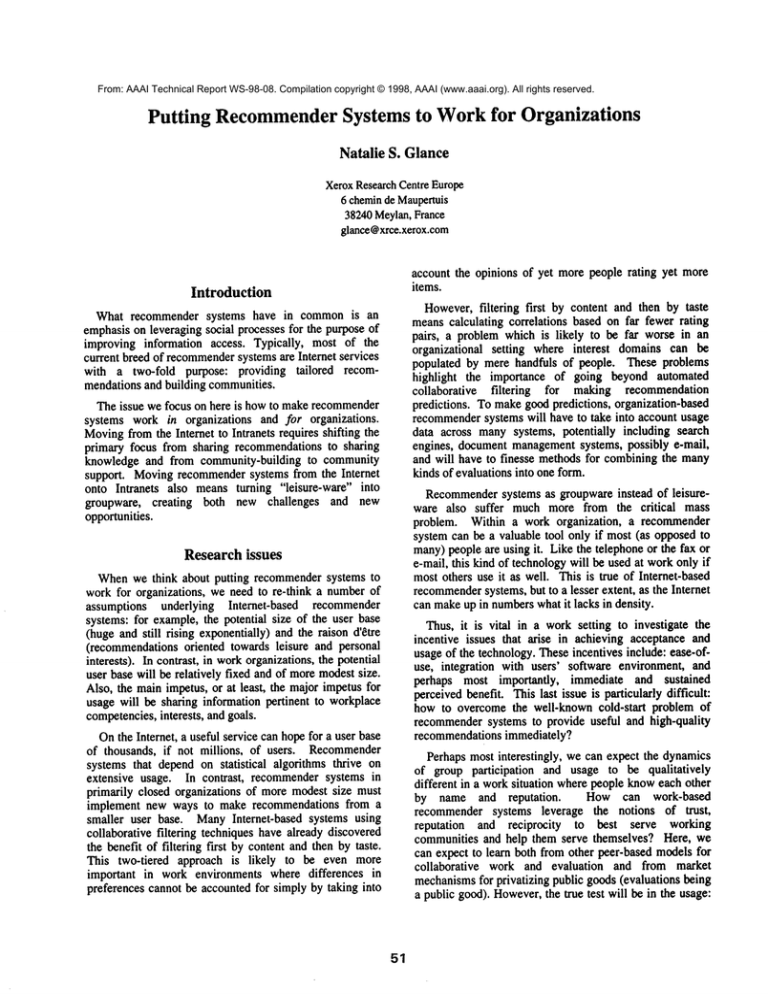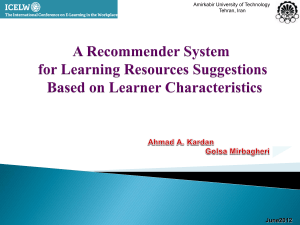
From: AAAI Technical Report WS-98-08. Compilation copyright © 1998, AAAI (www.aaai.org). All rights reserved.
Putting Recommender
Systems to Workfor Organizations
Natalie S. Glance
XeroxResearchCentre Europe
6 eheminde Maupertuis
38240Meylan,France
glance@xrce.xerox.com
Introduction
What recommender systems have in common is an
emphasison leveraging social processes for the purpose of
improving information access. Typically, most of the
current breed of recommender
systems are Internet services
with a two-fold purpose: providing tailored recommendations and building communities.
The issue we focus on here is howto makerecommender
systems work in organizations and for organizations.
Movingfrom the Internet to Intranets requires shifting the
primary focus from sharing recommendations to sharing
knowledge and from community-building to community
support. Movingrecommendersystems from the Internet
onto Intranets also means turning "leisure-ware" into
groupware, creating both new challenges and new
opportunities.
Research issues
Whenwe think about putting recommendersystems to
work for organizations, we need to re-think a number of
assumptions underlying Internet-based recommender
systems: for example, the potential size of the user base
(huge and still rising exponentially) and the raison d’etre
(recommendations oriented towards leisure and personal
interests). In contrast, in workorganizations, the potential
user base will be relatively fixed and of moremodestsize.
Also, the main impetus, or at least, the major impetus for
usage will be sharing information pertinent to workplace
competencies,interests, and goals.
Onthe Internet, a useful service can hope for a user base
of thousands, if not millions, of users. Recommender
systems that depend on statistical algorithms thrive on
extensive usage. In contrast, recommendersystems in
primarily closed organizations of more modest size must
implement new ways to make recommendations from a
smaller user base. ManyInternet-based systems using
collaborative filtering techniques have already discovered
the benefit of filtering first by content and then by taste.
This two-tiered approach is likely to be even more
important in work environments where differences in
preferences cannot be accounted for simply by taking into
account the opinions of yet more people rating yet more
items.
However,filtering first by content and then by taste
means calculating correlations based on far fewer rating
pairs, a problem which is likely to be far worse in an
organizational setting where interest domains can be
populated by mere handfuls of people. These problems
highlight the importance of going beyond automated
collaborative
filtering
for making recommendation
predictions. To makegood predictions, organization-based
recommendersystems will have to take into account usage
data across manysystems, potentially including search
engines, document managementsystems, possibly e-mall,
and will have to finesse methods for combiningthe many
kinds of evaluations into one form.
Recommender
systems as groupware instead of leisureware also suffer much more from the critical
mass
problem. Within a work organization, a recommender
system can be a valuable tool only if most (as opposedto
many)people are using it. Like the telephone or the fax or
e-mail, this kind of technologywill be used at workonly if
most others use it as well. This is true of Internet-based
recommender
systems, but to a lesser extent, as the Internet
can makeup in numberswhat it lacks in density.
Thus, it is vital in a work setting to investigate the
incentive issues that arise in achieving acceptance and
usage of the technology. Theseincentives include: ease-ofuse, integration with users’ software environment, and
perhaps most importantly, immediate and sustained
perceivedbenefit. This last issue is particularly difficult:
how to overcome the well-known cold-start problem of
recommendersystems to provide useful and high-quality
recommendations immediately?
Perhaps most interestingly, we can expect the dynamics
of group participation and usage to be qualitatively
different in a work situation where people knoweach other
by name and reputation.
How can work-based
recommender systems leverage the notions of trust,
reputation and reciprocity
to best serve working
communities and help them serve themselves? Here, we
can expect to learn both from other peer-based modelsfor
collaborative
work and evaluation and from market
mechanismsfor privatizing public goods(evaluations being
a public good). However,the true test will be in the usage:
in this sense, work-centric recommendersystems are just
like their Internet cousins; they serve as platforms for novel
social experimentsand institutions.
Finally, while Internet-based recommendersystems
focus on creating communitiesby bringing people together,
Intranet-based recommender systems should focus on
supporting communities that already exist. The power of
recommendersystems to help people find each other is
multiplied manytimes over in an organization: locating
experts; reducing re-work by bringing together people
workingin the samearea in different geographiclocations;
and identifying competencies, both established ones and
emerging ones.
enhancingcontent-based collaborative filtering that (1) are
able to immediately
make reasonably
good
recommendationsfor a new user; and (2) take into account
usagedata across different software tools.
¯ Weare studying howsystem feedback, visualization
tools and market mechanismscan be used to influence the
dynamicsof group participation.
Currently, we have a working research prototype of our
knowledgesharing system that is being used by a group of
30 people internally (see Figure 1). In the short term,
will be enlarging the user base to include the Grenoblelab
and affiliates within Xerox.
Further reading
Current research activities
At XRCEGrenoble, we are pursuing several concurrent
threads of activity regarding organization-based recommender systems:
¯ We are developing a recommender system component as part of a larger knowledgemanagementplatform
for supporting knowledgesharing.
¯
Weare investigating
new prediction algorithms
Glance, N. S., Arregui, D., and Dardenne, M. 1998.
Knowledge Pump: Supporting the Flow and Use of
Knowledge. In Information Technology for Knowledge
Management, Ed. U. Borghoff and R. Pareschi, NY:
Springer-Verlag.
Glance, N. S., Arregui, D., and Dardenne, M. 1998.
Making RecommenderSystems Work for Organizations.
Submitted to CSCW’98.
INFLOW
Recommendations
for Christer Fernstrom
Last updatedon March2~, 1~)8
Development/Applications : Knowledse Management
OUTFLOW
INFLOW
:~] * * ~ ¯ ~ Inference Metasearchfor InterIwt
Reviewed
by: DaveSnowdon
(first submittedon Jan 4,1998,1hits)
~ * ~/tResearch-lt!
Collection
ofinformation
soqr~c.y~
Reviewed
by:Michael
Koch
(first
submitted
onJanI,1998,
2 hits)
OUTFLOW
IHfLOW
Research: Informationaccess
~.~]H * * * Learning
Information
Retrieval
A eer~t~
byMarko
~latmnovlc,
Yoav
Shoham
Reviewed
by:Michael
Koch
(first
submitted
onJan79,1998,
2 hits)
* ~ * ~ Collaborative
Filtering
Resources
byHalVtrlan
Reviewed
by:Michael
Koch,
Natalie
Glance,
lutta
Willamowski
(first
submitted
onDee12,
1997,
3hits)
Figure 1. "What’s Recommended?"
by the KnowledgePumptoday.
52
OUTFLOW
INFLOW
OUTFLOW


